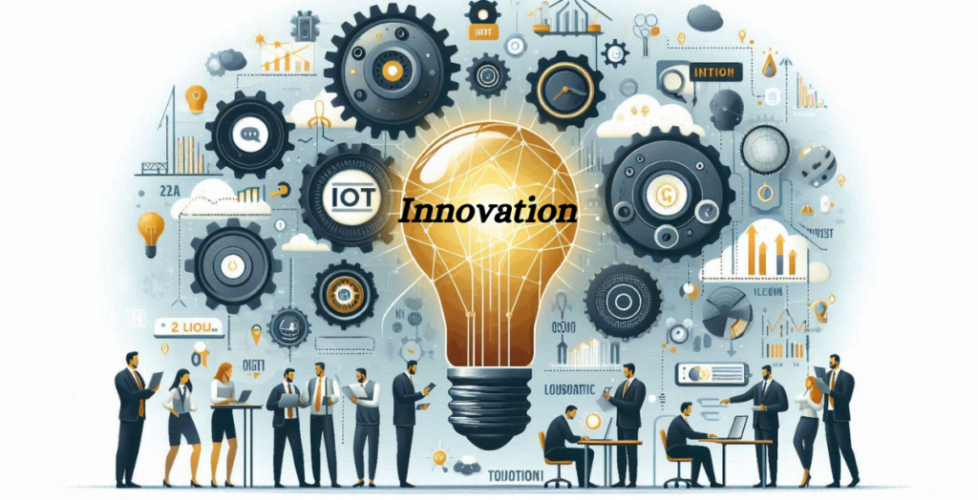IoT: The Engine of Business Innovation
The Internet of Things (IoT) guides the extensive web of corresponding devices that share and exchange data over the Internet. These machines range from intelligent refrigerators and thermostats to brutal industrial machinery. Consequently, IoT revolutionizes business operations by delivering real-time data, automating operations, and enabling new business standards.
This article concentrates on “business processes,” the various operations, procedures, and assignments companies commit to delivering value to their clients. By combining IoT technologies, businesses can significantly improve these techniques, making them more efficient, innovative, and customer-centric.
Indeed, IoT has great potential for business development, particularly in driving IoT-driven innovation in business processes. It introduces new ways to improve efficiency, forms new means of generating revenue, and enhances the traditional approach to customers. Furthermore, it allows for transforming business processes into automated and data-driven solutions by providing the ability to work with real-time information, thus increasing the possibilities of reaching all customers and creating individual services.
Read Also: Innovation for Beginners: How to Stay Ahead of Market Changes
Examples of IoT-driven Innovation in Business Processes
The publication “The Process of Business Model Innovation Driven by IoT: Exploring the Case of Independent SMEs” delivers valuable insights into how Small and Medium-sized Enterprises (SMEs) adapt their industry ideals using IoT. For example, SMEs in the manufacturing sector are leveraging IoT to implement survey tools, anticipate needs, and decrease rest, leading to enhanced operating efficiency and product rate.
Let’s explore diverse examples across industries:
- Manufacturing (Smart Factories): IoT allows smart factories to have related machinery and tools for real-time monitoring and control. For instance, General Electric (GE) uses IoT detectors on its jet motors to gather performance data. This data-driven process leads to predictive care, significantly lowering operating costs.
- Logistics (Supply Chain Tracking): IoT widgets follow interests throughout the supply chain and provide real-time visibility into product levels, cargo status, and environmental conditions. Organizations like DHL are leveraging IoT to optimize ways, decrease fuel consumption, and provide timely deliveries, enhancing the efficiency of logistics processes.
- Healthcare (Remote Patient Monitoring): IoT gadgets like wearable health monitors certify healthcare providers to follow patient insides remotely. This ongoing monitoring leads to more suitable patient results and decreases the need for hospital stays. Philips Healthcare, for example, utilizes IoT to monitor patients with regular conditions, allowing early intervention and personalized treatment programs, thereby changing healthcare delivery.
- Retail (Personalized Shopping Experiences): In the retail sector, IoT technologies like intelligent shelves and beacons help merchants track inventory, analyze client behavior, and deliver personalized publicity. Amazon Go stores illustrate this by using IoT for a cashier-less shopping adventure. Customers can choose items and go, with dealings automatically processed via their Amazon accounts, resulting in a seamless and personalized shopping experience.
Critical Benefits of IoT-driven Innovation

IoT can automate assignments, optimize resource distribution, and facilitate workflows. In farming, IoT detectors can observe soil moisture levels and automate irrigation. These outcomes in water protection and raised crop yields demonstrate the efficiency achieved with IoT.
Real-time data from IoT detectors authorizes businesses to make knowledgeable decisions, enhance forecasting, and recognize possible problems proactively. Utility companies leverage IoT to monitor energy consumption habits and modify supply accordingly, decreasing waste and improving service dependability. This enables more informed decisions.
IoT authorizes businesses to create innovative outcomes and services, tap into new markets, and make subscription-based revenue measures. John Deere, for example, offers a subscription service for its IoT-enabled tractors. This benefit provides growers with real-time data on soil needs and crop health, increasing productivity and profitability and highlighting the potential for new revenue streams.
IoT can personalize client interchanges, deliver real-time assets, and enhance product usability, eventually improving the client experience. Tesla’s IoT-enabled cars are a prime example. These cars receive over-the-air software updates, supplying clients with new features and improvements without requiring a dealership visit. This smooth transition between technology improves the client experience in general.
Read: Unlock Efficiency: The Tech Innovation Advantage
Challenges and Considerations
The increasing number of IoT gadgets increases the risk of cyberattacks and data violations. Companies must execute strong security measures, such as encryption and key management, to protect exposed data and guarantee compliance with rules.
Research indicates that these challenges must be addressed to leverage IoT technologies fully. (Despite its potential, IoT presents challenges such as security and privacy vulnerabilities, interoperability issues, and high deployment costs). Combining IoT systems with living IT infrastructure can also pose challenges.
Businesses must carefully prepare and manage IoT performances, considering interoperability, scalability, and data administration. A well-defined process is essential for successful integration. Embracing IoT technologies necessitates a workforce with the talent to manage and leverage them virtually. Businesses must invest in activities and upskill their workers to handle this skills gap and maximize the benefits of IoT.
Conclusion
The Internet of Things can transform various industries’ operations to improve efficiency, generate new revenues, and deliver excellent customer value. IoT enables businesses to leverage competitive advantage and innovate their operations.
There is no one-size-fits-all solution to IoT implementation, as businesses need to find the best approach based on their particular requirements and challenges. These include security and privacy issues, integration challenges, and the need for human resources.
The use of IoT technologies will significantly affect business processes and will continue to increase. Organizations that adopt IoT are likely to become future leaders and generate more value for their customers and shareholders.
In summary, business process innovation through IoT has tremendous opportunities for organizations to transform their work and create value. Through IoT solutions, companies can enhance productivity, adopt predictive analytics, generate additional income, and enhance the customer journey. Nevertheless, for companies to reap the benefits of IoT, some challenges need to be overcome, and a proper plan for deploying the technology must be embraced. The future of the business environment is to embrace the integration of IoT and the factors that contribute to its success.
Also Read: Incremental Business Innovation Strategies: Your Guide to Sustainable Growth
